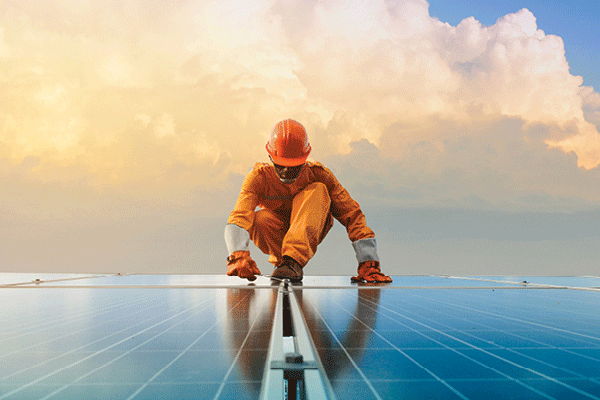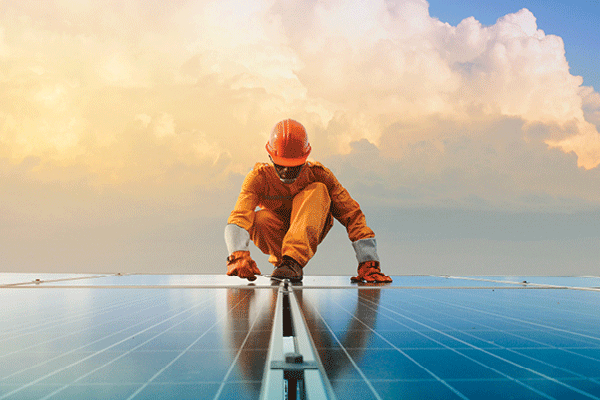
Japan has long been investing in infrastructure projects in Southeast Asia, but in recent years, the shift has been towards renewable energy projects.
This year marks the 45th anniversary since the start of exchanges between Japan and the Association of South East Asian Nations (ASEAN). As part of this relationship, Japan has been investing in infrastructure projects in the region since the early 1990s.
Southeast Asia is one of the world’s brightest economic spots, with a gross domestic product totalling over $2 trillion and a population of more than 600 million people. One of the region’s main growth engines has increasingly been infrastructure projects, and Japan has long been building everything from rails and airports to power plants with its technical expertise and experience.
Since the 2000s, Japan has backed 237 projects and invested a total of about $230 billion, according to BMI Research. For reference, China backed 191 projects and invested about $155 billion, though that’s expected to ramp up with its Belt and Road Initiative.
Recently, the projects Japan has been backing are focused on cleaner energy. One area has been moving from coal-fired power to gas-fired plants, observe Matthew Bubb and Anna Hermelin, Australia-based partner and Tokyo-based counsel at Ashurst, respectively, both of them specialise in financing and development of energy and infrastructure projects.
In 2015, members of the Organisation of Economic Cooperation and Development (OECD) struck a deal to end export credits for inefficient coal plant technology, due to coal being the most polluting of fossil fuels. The deal took effect in January 2017.
The new OECD agreement forced Japan to limit its coal technology exports for the first time, and essentially limited the ability of OECD export credit agencies, including Japan Bank for International Cooperation (JBIC) and Japan International Cooperation Agency (JICA), from financing coal-fired power plants, note Bubb and Hermelin.
Coal-fired power generally emits twice the amount of carbon dioxide compared to natural gas, but because of its low cost, coal has been attractive to developing countries, including those in Southeast Asia. But without JBIC or JICA Support, there is diminished financial incentive for Japanese companies to invest in new coal projects in Southeast Asia, say Bubb and Hermelin.
OECD members could make the restrictions even tighter next year after considering technological advances and research on global warming.
“This move to gas-fired power projects has also stimulated recent growth in investment in gas infrastructure projects, including regasification projects linked with power plants,” add the Ashurst lawyers.
In October, the Japanese government said it will offer $10 billion in support in joint private enterprise and government projects to supply liquefied natural gas (LNG) or build LNG infrastructure in Asia, particularly in the developing countries where the fuel is increasingly adopted.
RENEWABLES RISE
As Japanese infrastructure investments move towards more environmentally friendly forms of energy projects, they are also homing in on the renewables space.
“While there have been recent Japanese legislative changes to provide for risk capital incentives for investment in new upstream projects, increasingly, we are seeing investments into Southeast Asia in the renewables space, including, solar, wind, biomass and geothermal,” observes George Gibson, the Tokyo office head of Norton Rose Fulbright, who specialises in development and financing of infrastructure and energy-related projects, particularly in emerging markets.
Renewable energy is already being embraced at home in Japan, where it is one of the world’s largest renewable energy markets. The energy source wasn’t always popular and has been perceived to be unreliable and costly in the past, but after the Fukushima Daiichi nuclear disaster in 2011, Japan has looked towards renewable energy and hasn’t looked back since.
“We are also seeing Japanese companies’ internal investment policies placing a larger focus on the preservation of the ‘Global Environment’ – a mechanic which is often linked to export credit agency financing policies, and including JBIC,” notes Gibson.
“In our experience, while we are seeing continued investment into conventional independent thermal power projects, the impact of policies encouraging investment into green investments is evident with Japanese investment significantly increasing in the renewables space,” he says.
Bubb and Hermelin of Ashurst are also seeing Japanese companies transitioning into new energy projects, including renewables. “Many of our Japanese clients have made considerable investments in the booming domestic solar market, including the Japanese trading companies and utilities re-balance their generating portfolios and more utility-scale opportunities become available,” they note. “Japanese companies are leveraging their domestic know-how to sponsors solar projects across Southeast Asia.”
Just last month, Vietnamese electricity company Gia Lai Electricity signed a deal worth more than 5 billion yen ($47.4 million) with a Japanese plant engineering company, JGC, to design and build a solar power generation plant by November.
“Japanese companies are also world leaders in waste-to-energy incineration technology, and are looking for opportunities to invest in WTE as countries such as the Philippines and Indonesia seek new solutions to manage their waste,” add Bubb and Hermelin.
HYDROGEN ON THE HORIZON
Another form of cleaner energy that’s heating up is hydrogen fuel, which Norton Rose’s Gibson is expecting to see more investment in. Hydrogen is seeing an increased focus from both Japanese corporates and the government.
“Norton Rose Fulbright has seen increased engagement with foreign and Japanese clients discussing potential investments in the sector,” says Gibson. “Of interest for Japanese investors is the broad value chain – from supply, transportation, electrolysis/hydrogenation and storage – to the broad hydrogen economy platform for industrial use, transportation, electrical generation and heat supply.”
“While the sector is in its infancy, and has significant obstacles to overcome to become commercially viable, we are expecting increased focus by Japanese companies on the hydrogen economy over the coming period,” he notes.
Governments looking for environmentally-friendly fuel are particularly attracted to hydrogen, which is zero-emission and the only by-product is water. Japan recently made progress at home, with an alliance of 11 Japanese firms, including automakers and energy firms, pledging to build 80 fuelling stations for hydrogen fuel-cell vehicles by 2022 to help accelerate take-up of the next-generation fuel technology, Reuters reported last month.
As countries seek low emissions energy sources to power vehicles, homes and industry, Japan is betting heavily on becoming a “hydrogen society” despite the high costs and technical difficulties of a process that creates electricity from a chemical reaction of fuel and oxygen.
BULLET TRAIN TECHNOLOGY
Also on track for increased infrastructure investments coming out of Japan is transport, particularly in ports, airports and in rail, including Shinkansen or high-speed rail, say Bubb and Hermelin.
“Japan is exporting its Shinkansen technology for the Thailand high-speed rail project and the Japanese government is strongly supporting the Japanese consortium's bid to use Shinkansen technology for the Singapore-Kuala Lumpur high-speed rail project,” they note.
Although there were reports of roadblocks between Japan and Thailand with the Southeast Asian country considering to lower the maximum speed of the high-speed rail to reduce the overall cost of the project as well as regarding the financing of it, the Bangkok Post reported in February that the Thai government has insisted the Thailand-Japan partnership for joint investment in the high-speed railway project from Bangkok to Chiang Mai remains intact.
Japan’s JICA conducted a study and found that the entire Bangkok-Chiang Mai route will cost 420 billion baht (about $13 billion).
And as for the Kuala Lumpur-Singapore high-speed rail project, it seems to be on track with Japan’s ambassador to Malaysia telling Malaysian news agency Bernama in January that Japan has its eyes set on bidding for the rights to construct the project and is slated to be ready by the end of 2026.
AIRPORTS
Other Japanese infrastructure projects to look out for in Southeast Asia include airports. “Japanese companies are also leveraging their experience in building, rehabilitating and operating airports to invest in Southeast Asia,” say Bubb and Hermelin.
“A Japanese consortium signed a 30-year concession to operate Myanmar's Mandalay airport and were actively looking at airport projects in the Philippines, before many of these were changed or put on hold by the [Rodrigo] Duterte administration.”
Duterte, the Philippine president, is still keen on airport investment, regarding it as a key part of his $180 billion infrastructure programme, particularly to upgrade the country’s creaky transport network. His “Build, Build, Build,” policy plans to boost infrastructure spending to 7.3 percent of GDP by 2022 from 6.3 percent this year.
“We have also started to see increased Japanese participation in social infrastructures, such as schools and hospitals as well,” note Bubb and Hermelin. “There have been a relatively small number of investments so far, mostly in the hospital sector, as Japanese need time to get comfortable with this new area of investment and understand the risk profile of such projects. PPPs in the social infrastructure sector, particularly education and health, will also be targets for growth opportunities.”
SOUTHEAST ASIA CHALLENGES
Infrastructure projects work, like elsewhere in the world, has its challenges when advising clients, but there are some that are especially so in the emerging markets of Southeast Asia.
“There are legal issues that are common to most infrastructure projects in the region, including ownership restrictions, termination regimes and land appropriation,” notes Damien Roberts, a partner in Herbert Smith Freehills’ Tokyo office specialising in cross-border acquisitions, resource projects and infrastructure matters. “These can really only be dealt with on a case-by-case basis and through close collaboration with the investor's local partners.”
One of the single biggest issues lawyers face is how to fit multi-party infrastructure offerings into regulatory frameworks that are still being modernised to accommodate sophisticated project structures.
“To help overcome this, our network of offices across Asia collaborate closely to ensure that we understand the risk profiles likely to be adopted in the host environments, to share our learnings with all parties at an early stage of any project to help manage expectations, and as appropriate to offer our experience to all parties in a transaction in a way that ensures the ultimate deliverable is a win-win project for all,” he says.
For Norton Rose’s Gibson, some of the regular challenges are issues around bankability in emerging markets. “In emerging market jurisdictions, issues around bankability and having a sufficiently robust risk profile that satisfy the needs of all the stakeholders, and especially investors and any supporting international financial institutions as regards the development and financing of infrastructure projects are key issues,” he says. “A key bankability issue is, for example, who bears the risk of any changes in law that affect the relevant infrastructure project.”
And changes in law is another challenge. “Indonesia is a good example of a jurisdiction where changes in law can cause issues for Japanese and other international investors,” he shares. “In the infrastructure space, recent Indonesian examples are changes to Indonesian government force majeure risk allocation, however, more recent changes have sought to resolve bankability concerns; and amendments to ownership thresholds limiting foreign entity ownership in Indonesian companies.”
Ashurst’s Bubb and Hermelin find that the legal and regulatory regimes in many countries there provide less certainty, and they need to work very closely with clients and their other advisers – including technical, insurance, taxation and commercial/financial advisers – to properly identify and manage all of the risks across a project. “Some of the solutions will be legal, but more often than not, the risks need to be managed through a combination of legal, technical and commercial techniques,” they say.
“Many officials are unsure how to interpret and apply the law to the new kinds of investment coming in, and they lack experience in international standard practice that usually helps procurement negotiations run more smoothly,” they say. “Some laws have not been updated since the time of European colonisation, meaning they are woefully out of date and inapplicable to modern infrastructure projects.”
“At the other end of the spectrum, emerging Southeast Asian nations that have newly updated procurement laws, corporate laws and the like, do not have any precedent for how to interpret and apply those laws, which leads to a lot of uncertainty.”
Political risk is also a significant challenge for sponsors, lenders and their lawyers doing work in Southeast Asia, they add, giving the example of the Philippines, where many projects in the middle of procurement or negotiation were suddenly put on hold after the change of government in 2016.
“Procurement authorities in Southeast Asia can be unpredictable counterparties: two projects in the country that are substantially similar can be structured very differently, with different risk profiles, and negotiations can result in very different outcomes,” they note. “While projects in Southeast Asia can be challenging, with a diligent and commercial approach, they can be very successful!”
Australia, U.S., India and Japan in talks to establish Belt and Road alternative: report
By Reuters
Australia, the United States, India and Japan are talking about establishing a joint regional infrastructure scheme as an alternative to China’s multibillion-dollar Belt and Road Initiative in an attempt to counter Beijing’s spreading influence, the Australian Financial Review has reported, citing a senior U.S. official.
The unnamed official was quoted as saying the plan involving the four regional partners was still “nascent.” The official said, however, that the project was on the agenda for Turnbull’s talks with U.S. President Donald Trump and was being seriously discussed. The source added that the preferred terminology was to call the plan an “alternative” to China’s Belt and Road Initiative, rather than a “rival.”
“No one is saying China should not build infrastructure,” the official was quoted as saying. “China might build a port which, on its own is not economically viable. We could make it economically viable by building a road or rail line linking that port.”
Japanese Chief Cabinet Secretary Yoshihide Suga, asked at a news conference about the report of four-way cooperation, said Japan, the United States, Australia, and Japan, Australia and India regularly exchanged views on issues of common interest.
“It is not the case that this is to counter China’s Belt and Road,” he said.
Japan, meanwhile, plans to use its official development assistance (ODA) to promote a broader “Free and Open Indo-Pacific Strategy” including “high-quality infrastructure”, according to a summary draft of its 2017 white paper on ODA. The Indo-Pacific strategy has been endorsed by Washington and is also seen as a counter to the Belt and Road Initiative.
First mentioned during a speech by Chinese President Xi Jinping’s to university students in Kazakhstan in 2013, China’s Belt and Road plan is a vehicle for the Asian country to take a greater role on the international stage by funding and building global transport and trade links in more than 60 countries.
Xi has heavily promoted the initiative, inviting world leaders to Beijing last May for an inaugural summit at which he pledged $124 billion in funding for the plan, and enshrining it into the ruling Communist Party’s constitution in October.
Local Chinese governments, as well as state and private firms, have rushed to offer support by investing overseas and making loans.
In January, Beijing outlined its ambitions to extend the initiative to the Arctic by developing shipping lanes opened up by global warming, forming a “Polar Silk Road”.
The United States, Japan, India and Australia have recently revived four-way talks to deepen security cooperation and coordinate alternatives for regional infrastructure financing to that offered by China.
The so-called Quad to discuss and cooperate on security first met as an initiative a decade ago - much to the annoyance of China, which saw it as an attempt by regional democracies to contain its advances. The quartet held talks in Manila on the sidelines of the November ASEAN and East Asia Summits.


